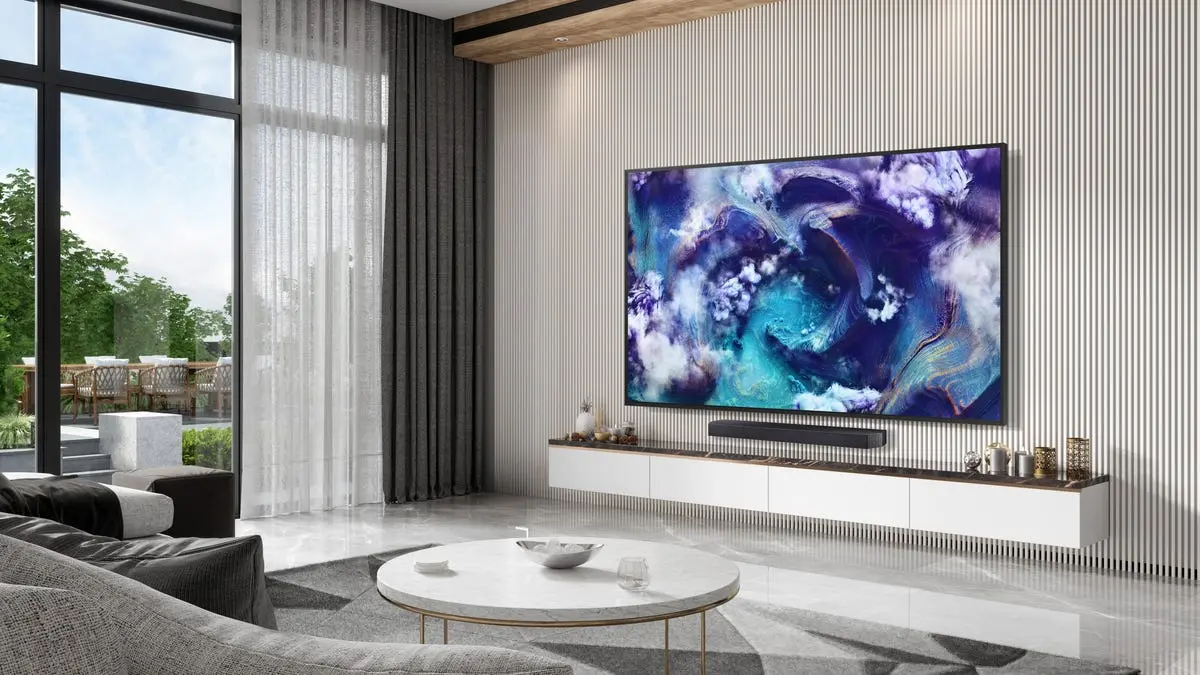LG and Samsung OLED TVs: Price Drops and Technological Advancements
2 Sources
2 Sources
[1]
One of the best LG OLED TVs I've tested is now hundreds of dollars off, permanently
I'll get straight to the point. I test a lot of TVs. When I found out I would be trying out LG's G3 along with one of the company's new soundbars, I knew I would be watching a highly-touted TV. Even though it's more than a year old now and LG has replaced it with the G4, this is still an incredible television. It's one of the best-looking TVs I've ever tested, both in terms of the display and the design of the set itself. It packs very impressive audio and a ton of features into its slim design, and any content I tried out looked beautiful. Also: The best TVs: Expert tested The G3 is available in sizes from 55 to 83 inches. For the purposes of this review, I tested the 65-inch. Let's dive into what makes this TV so good. Right out of the box, I noticed how sleek the G3 is. At only an inch thick and with an almost non-existent bezel, it's designed to sit flush on a wall. Since I was only enjoying it temporarily, I instead opted to mount it on a stand, but it still looked elegant. Also: The best LG TVs of 2024: Expert tested and reviewed This set has four HDMI 2.1 eARC ports. All the inputs are in a small cutout on the left side of the TV that I found easy to access. Some TVs place inputs right in the middle, making them difficult to get to, but I didn't have any issues connecting everything I wanted to the G3. I'm a fan of physical media, so the first thing I usually do when I put a TV through its paces is fire up a Blu-ray disc. For this test, I picked a personal favorite movie: "Ghostbusters." I felt like I was watching it for the first time. There are quite a few darker scenes in this movie, and I was able to pick out details I hadn't noticed before. I felt like the G3 handled upscaling better than most TVs I encountered. Also: I tested this 'Free TV' in return for watching targeted ads - and was pleasantly surprised To test something a little more modern, I went to Netflix and started the first thing I saw - the new "Beverly Hills Cop: Axel F." A good mix of bright and dark scenes impressed me even more. Colors were incredibly vibrant when they were supposed to be, and dark scenes were never washed out. I'll call this easily one of the better displays I've seen on a television. It incorporates Micro Lens Array technology, or a layer of microscopic lenses on top of the OLED pixels that supposedly takes brightness to new levels. I especially noticed this when I tested a few games, and now my everyday screen looks dull by comparison. In terms of audio, the G3 supports Dolby Atmos and LG claims that the built-in AI transforms two-channel audio into virtual 7.1.2 surround sound. While it isn't "actual" surround sound, I was very impressed with the audio, and I could tell it was a significant leap from standard TV speakers. There are several additional audio presets as well, such as sports, music, clear voice, and cinema, which adds a nice bass rumble to action scenes. Also: LG vs Samsung TV: Which brand should you buy in 2024? One of the small things I appreciate the most about the G3 is how well it handles harsh lighting. My living room has a lot of natural light spilling in from the side and a bright overhead light. While testing this TV, I had it sitting in front of my regular TV, which is a wall-mounted LED. The difference between the two was immediately noticeable. The side light didn't impact the G3 at all, and while a reflection from my overhead light was visible, it wasn't distracting. On my everyday TV, it detracts from the display quite a bit. The anti-glare screen coupled with this set's 1,400 nits of brightness means you'll be able to enjoy content in any condition, especially bright windows, the bane of most TVs. When it came time to give gaming a run, I quickly discovered this was going to be one of my favorite tests. As I mentioned before, the G3 has an incredibly vibrant display, and it truly shined here. No matter the game, colors were more vibrant than ever, but still quite natural at the same time. The 120Hz refresh rate is enough to make sure everything runs smoothly, and I never noticed any stuttering or slowdowns. Also: The best 4K TVs of 2024: Expert tested and reviewed I usually don't tinker too much with settings, but I enjoyed nosing around the Game Optimizer menu to see what changes different options made. Most gamers probably won't even notice these changes, but dedicated ones will. When the LG G3 debuted, it carried an MSRP of $3,299.99 for the 65-inch version. That price is at the higher end for an OLED, so it certainly scared some people off. Now that the G4 is out, the price for last year's set is down to around $2,000 at most retailers, including Amazon and Best Buy. If you're looking for a new TV, the savings should be awfully tempting. I really couldn't pick one area this set excels at, as it does a phenomenal job at everything. If you're looking for a more premium OLED TV but can't stomach the premium prices that usually come along with them, you won't find many better options than the G3.
[2]
Is the Samsung S95D OLED the best TV choice for 2024?
We reviewed Samsung's £2,900 flagship at home and found one key innovation that puts it ahead of the pack This article contains affiliate links. The products or services listed have been selected independently by journalists after hands-on testing or sourcing expert opinions. We may earn a commission when you click a link, buy a product or subscribe to a service. Price: £2,899 for 65-inch Samsung S95D tested (also available in 55-inch and 75-inch) Our rating: 10 out of 10 We like: best ever OLED for daytime viewing, superb dynamic range We don't like: no Dolby Vision and not quite best-in-class audio What is the Samsung S95D? This is Samsung's most advanced 4K OLED TV in 2024. They make 8K televisions with greater resolution, such as the QN900D, but they are very expensive indeed (and there is very little 8K content to watch). They also make 4K TVs with non-OLED screens, such as the QN90D, which go slightly brighter. But the S95D is our pick for the best Samsung television right now. Its main competitors are LG's excellent G4 OLED, which came out this year, and Sony's A95L OLED, which is older but still regarded as the state of the art. We wanted to see how the new Samsung measured up. At the back of our mind was the fact that Samsung's previous flagship OLED, the S95C, which is only a year old, can now be picked up for around £1,800. Would the S95D's increased brightness and new, upscaling AI chip justify the upgrade? Or would something else surprise us? How we test televisions Every TV is tested at home for a minimum of two weeks. We play a variety of content in standard, high and ultra-high definition, from movies to nature programmes, sport and daytime viewing. We evaluate the picture and sound, see how easy the TV is to set up and operate and check how well it performs with gaming consoles and other peripherals. We're looking for everyday usability as well as the wow factor. Visit our Who We Are page to learn more about Telegraph Recommended reviews. Design and technology: 10 out of 10 As we were setting the Samsung S95D up to review at home, my wife could not believe that the whole, 65-inch television was the same thickness as her iPhone. Given that the first TV we ever bought measured two feet from front to back, the evolution is jaw-dropping. We sometimes forget how important the material aspect of televisions is. For instance, the S95D has a new anti-glare coating that cuts out almost all reflection from windows or lamps. I somehow hadn't read about this before reviewing it, but it explains why I was enjoying watching movies on a sunny afternoon, something you didn't used to be able to do. It's also worth noting the S95D's stand, remarkably stable despite its small footprint, and the One Connect box which slots neatly onto it. All your input and output cables plug into the One Connect box, which you can keep several feet away from the television, attached by a single slim wire, if you want to mount the TV neatly on the wall. (Or, in my case, if you need reading glasses to plug a USB cable in the right way round.) Inside the S95D is a new AI processor called the NQ4 AI Gen2. This replaces the NQ 4K. Each generation gives better upscaling and better enhancements of sound and picture. This time, the key abilities are Real Depth Enhancer, which adds detail to the area of the picture you're looking at, and HDR Pro, which uses the new screen's higher peak brightness to extend the dynamic range. Picture quality: 10 out of 10 Where other OLED-makers, such as LG, use micro lens arrays to boost the brightness of their OLED TVs, Samsung uses light-intensifying quantum dots. They unveiled this 'QD-OLED' tech in 2022, with the S95B, and improved it in 2023 with the S95C. The S95D is noticeably better. The first word I wrote in my notes was 'beautiful'. I was watching Dune 2 - on a sunny afternoon, by the way - and Denis Villeneuve's challenging palette of subtle ochres, luminous blues, blinding sunlight and inky blacks looked absolutely gorgeous. One scene takes place in a dark room, both actors dressed entirely in black, with flashes of blinding desert sunlight entering through portholes. That is a recipe for disaster on an old-fashioned LED TV. Here, with OLED's ability to turn pixels off completely for 'full black' and QD's ability to boost brightness, you could see intricate detail across the full spectrum. Remarkable. Later, watching the forest fire scene in Alex Garland's Civil War, the handling of different types of light - sparks, flames, car headlights, fireflies - was jaw-dropping. I was forced to go watch the same scene on the Sony A95L, which I have always considered the best screen you can buy. It's a close-run thing. The Samsung is stupendously detailed and pretty. If you had to criticise it, you'd say the colours here are painterly rather than strictly true-to-life (although they're much more realistic than previous Samsung OLEDs). It's a very fine distinction, but there's a lingering sense of enhancement. You may actually prefer it. After a week, I did. It brought a liveliness to everyday telly (Gardener's World, The Chaser, James Martin's show) and gave an extra presence to bread-and-butter movies (The Fall Guy, Crazy Stupid Love). One definite criticism is the judder reduction. It has settings from zero to 10, none of which was right. When the camera panned at certain speeds, the judder ranged from bad to unwatchable. This was especially noticeable on low-definition content. It's a problem shared with all OLEDs due to their high screen-refresh rate, and remains one of the last nuts to crack before they reach a state of perfection. Sound: 8 out of 10 It feels a bit mean criticising a TV that is just over a centimetre thick for not having cinema-quality sound. In fact, the eight built-in speakers manage impressive clarity and depth as well as object-tracking (where the sound appears to be coming from the part of the screen where the action is happening). The S95D supports Dolby Atmos but using the built-in speakers alone, any surround-sound effect feels as though it's coming from around the edges of the screen, rather than around you. Having shelled out £2,000 on the TV, you should plan on adding a few hundred more for a soundbar and, if you can stretch to it, a separate subwoofer. Samsung's two-piece systems start at about £200. You do need a Samsung soundbar for the Q-Symphony feature, which combines the TV's speakers with the separates for a rich, encompassing soundscape. Having tried it on last year's S95C, I'd recommend it. Usability: 8 out of 10 The S95D was reasonably quick to set up, the One Connect box simplifying things physically and the Samsung SmartThings app minimising fiddly button-pressing. I find SmartThings pretty glitchy as a rule, but if you've had a Samsung TV before you can save all your settings to the app and transfer them instantly to the new TV, which is a very neat trick. This includes wi-fi connections to other devices. Samsung's Tizen operating system is not the loveliest to use in the world, but there have been improvements here. The home screen has three simple tabs: one for live TV, one for streaming apps such as Netflix and 'For You', which knows what you've been watching and makes it easy either to pick up where you left off, or find something similar. Different family members can each have their own For You selection. There seem to be far fewer picture and sound settings to meddle with now, with AI doing the job of working out what you like, or what the director intended, or what the scene requires. I started watching with the picture mode set to AI Customisation. The TV ran a basic multiple choice test, asking me which of four images I preferred for watching sport, films and general viewing. After that it never asked me again. In fact I couldn't find a way of seeing whether it was using Standard, Dynamic, FilmMaker or any of the other modes you usually choose between. 'AI Customisation' was all it would tell me. I was actually very happy with this. I hate a vivid picture and the S95D seemed to lean more towards naturalism - a first for any Samsung I've reviewed. The AI must work. The S95D, as is usual for Samsung, comes with two remote controls; one long, old-fashioned one with 42 buttons that your dad will prefer and one small, simplified one with 15 buttons, which you will use. There's a solar panel on the back so, as long as you leave it in the light (indoor light is enough), you will never need to buy a battery. Gaming: 9 out of 10 There are four HDMI 2.1 ports on the One Connect box, one of which supports eARC for passing lossless audio to your soundbar. The other three can be used for gaming inputs and you'll be able to play in 4K resolution at 120Hz, or 144Hz if you have a PC that goes that fast. Input lag is just 9.8 milliseconds, comfortably faster than the 15ms hardcore gamers demand (casual gamers like me are usually happy with 40ms). Variable refresh rate, which syncs the screen refresh to the console's output to prevent tearing and stuttering, is handled by AMD Freesync Premium Pro. There's no Dolby Vision Game mode because Samsung rejects Dolby Vision, using HDR10+ instead. I'm a PS5 gamer and I put in several hours on fast-twitch Call of Duty and graphically demanding Ghost of Tsushima, both of which looked gorgeous and played smoothly on the S95D. The AI knows the difference between the two and optimises for either speed or graphics. Samsung's game bar (pictured) is the same as every other OLED manufacturer's, letting you check various settings and change them in-game. One nice feature is the Game Hub on the home page, collating favourite games not just on your consoles but any game streaming services, like Xbox Game Pass and GeForce Now. Tech specs and comparison Let's compare the Samsung S95D to its closest competitor, the LG G4, which came out around the same time. We'll see the LG is a tad cheaper and supports Dolby Vision - but the Samsung inches it on screen technology, built-in sound and game streaming. Verdict With its brighter output and better AI, the Samsung S95D is a notable advance over previous Samsung OLEDs. Colours are more realistic and dynamic range is expanded, with sparkling highlights and more detail in the shadows. What actually makes it worth the considerable extra cost, however, is the anti-glare screen. This makes the S95D a superb everyday TV, working in bright daylight as well as low-lit home cinema conditions. We think it's ever so slightly better than the LG G4 and neck-and-neck with the Sony A95L, its two main competitors. Since the Sony is still more expensive, the Samsung becomes the better all-round choice - particularly if you can pick it up bundled with a soundbar (which we would recommend) in one of the frequent sales. £2,899 Buy now Price for 65in model at Samsung FAQs What are the key features of the Samsung S95D OLED TV? The standout features are its very effective anti-glare screen, which makes it better for watching in daylight, and its high peak brightness, which adds realism to sparkles, reflections and shafts of light and unveils more detail within scenes. The S95D also has a better central processing unit than the outgoing S95C model, but otherwise shares many of its key features, such as the One Connect Box that makes connecting peripherals easier and tidier, the solar-powered remote, the small metal stand and the object-tracking sound. How does the Samsung S95D OLED compare to other OLED models? Outside of Samsung, the best OLED models are produced by LG and Sony. We think the Samsung S95D is slightly better than the LG G4 and not quite as good as the Sony A95L, but given the price we would choose the Samsung. Within Samsung's own range, you could choose the S95C OLED from last year and save about £500. It is not as bright as the S95D and lacks the anti-glare screen, but is a superb TV. Further down Samsung's OLED range are the new S90D OLED, without the anti-glare and with only 40W of audio output, and the S85D OLED which has 20W of audio power and slightly less dynamic range. What screen sizes are available for the Samsung S95D OLED TV? 55 inch, 65 inch and 75 inch What is the gaming like on the Samsung S95D OLED TV? Gaming is superb, with a very low lag time of 9.8milliseconds and support for 4K gaming at up to 144Hz. It has HGiG tone mapping for better contrast and AMD FreeSync Premium Pro VRR to prevent screen tear and stutter. The S95D has three HDMI 2.1 ports and has the Xbox streaming app built in, allowing you to play games with just a controller as long as you have an Xbox game pass.
Share
Share
Copy Link
LG permanently reduces prices on its C3 OLED TV series, while Samsung introduces the S95D OLED TV with advanced anti-glare technology. Both companies continue to push the boundaries of TV technology.

LG C3 OLED TV Series Gets Permanent Price Cut
LG has announced a significant and permanent price reduction for its popular C3 OLED TV series. The 42-inch model, which previously retailed for $1,399, is now available for $999, marking a substantial $400 price drop
1
. This move makes high-quality OLED technology more accessible to a broader range of consumers.The C3 series is known for its exceptional picture quality, featuring deep blacks, vibrant colors, and high contrast ratios characteristic of OLED displays. It also boasts a 120Hz refresh rate, making it an excellent choice for both movie enthusiasts and gamers alike.
Samsung Introduces S95D OLED TV with Advanced Anti-Glare Technology
While LG focuses on pricing strategy, Samsung is pushing the boundaries of OLED technology with its new S95D OLED TV. The S95D introduces a groundbreaking anti-glare technology that addresses one of the primary concerns with OLED displays: reflections in bright environments
2
.Samsung's new anti-reflective coating significantly reduces glare without compromising the TV's color accuracy or contrast. This innovation allows viewers to enjoy the superior picture quality of OLED technology even in well-lit rooms, expanding the versatility of these high-end displays.
Competitive Landscape in the OLED TV Market
The contrasting approaches of LG and Samsung highlight the intense competition in the premium TV market. LG's price reduction strategy aims to make OLED technology more accessible to a wider audience, potentially increasing market share. On the other hand, Samsung's focus on technological innovation seeks to differentiate its products and justify premium pricing.
These developments are likely to benefit consumers, as they now have access to more affordable OLED options from LG, as well as technologically advanced models from Samsung that address previous limitations of OLED displays.
Related Stories
Impact on the TV Industry
The permanent price reduction of LG's C3 series and Samsung's technological advancements in the S95D model are expected to have significant implications for the TV industry. These moves may prompt other manufacturers to reassess their pricing strategies and accelerate their research and development efforts to remain competitive.
As OLED technology becomes more affordable and continues to improve, it is likely to further erode the market share of traditional LED-LCD TVs in the premium segment. This shift could lead to increased investment in OLED production, potentially driving down costs across the industry in the long term.
References
Summarized by
Navi
[2]
Related Stories
Weekly Highlights
1
Google Unveils Gemini 3 AI Model with Record-Breaking Performance and New Coding IDE
Technology

2
Microsoft Transforms Windows 11 Into 'Agentic OS' with AI Agents That Work in Background
Technology

3
Trump Launches Genesis Mission: Massive AI Initiative to Accelerate Scientific Discovery
Science and Research








